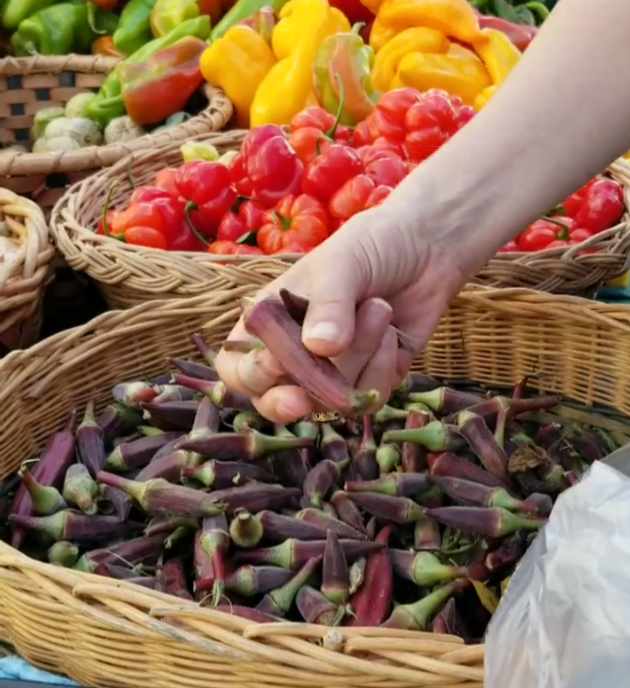Pass the Okra, Please!
Let’s get real here, people! I was never a big fan of okra when I was a kid.
Heirloom red okra from Norwich Meadows Farm
99.9% of the time I have high praise for my mother’s cooking. But there was ONE DISH, one nasty slimy 1% dish that she made on Halloween—it was okra baked in a tomato-meat sauce & it was AWFUL! Talk about SLIME before anyone was sliming anyone. And somehow, we had to find a way to slide that stuff down our throats before we were allowed to go trick or treat. (I’m sure my mother thought it was the one time she would get us to eat okra!) But the memory alone makes my face frown. Yuk!
But then gumbo came into my life. My opinion of okra completely changed when my mother first starting making us seafood gumbo in the summer. She found an old Southern recipe and some gumbo filé, and the rest is history. Combining crabmeat and okra and tomatoes in that light sauce led me straight to okra heaven! Now I understood cooked okra’s tasty thickening magic, and I’m most grateful my mother found that recipe.
But I’m gonna go out on a limb and tell y’all that what I learned this week from my good friend, Roswell, and his mother treats okra even BETTER!! Hailing from Covington, Louisiana, the Pogue family has a long history working in the restaurant industry, and Mrs. Pogue is a phenomenal cook. She taught me her secret of how to put okra into a gumbo with ZERO slime, so I know you’ll want to watch how to do that! Plus, I found some gorgeous tender heirloom red okra (though I think it looks like a gorgeous burgundy) at the Union Square greenmarket thanks to Norwich Meadows Farm. So this week’s recipe for a Chicken & Duck Sausage Cajun Gumbo is courtesy of Bettie Pogue’s wonderful cooking lesson.
First things first—okra is the reason we gumbo! The word gumbo is derived from the African word for the vegetable which is kingumbo. We’re still in okra season, if you can find someone growing okra in their garden or a farmer at your local market. It’s a fun fuzzy vegetable and the more tender it is, the easier it is to cook. A tender okra has flexibility or some give when you press on it. Of course when you start to slice it into circles, you’ll wonder why this plant wasn’t used for glue instead of consumption!
Then there’s the roux, which is the slow browning of flour with fat. Mrs. Pogue uses peanut oil, and let me tell you folks, provided there is no peanut allergy in your house, I beg you to try the peanut oil! The aroma alone whilst stirring the roux is phenomenal, plus I truly believe it gave my gumbo the basis for it’s multi-layered flavor profile. It definitely was the difference maker in terms of the overall flavor. As to making roux, there are many options from choice of fat—drippings, oil, shortening, butter—to how you brown—in the oven, microwave, or crockpot. But I think it’s fun to stick to the old method and slowly heat and stir the mixture in a skillet and watch the color turn from light caramel to pecan to coffee. Per Bettie’s instructions, I stopped at pecan, but I think I could have taken it even a bit further (to the color of the pecan shell?), and it would have been closer to Bettie’s pecan color. For my money, provided you don’t stop stirring at light caramel and you don’t get to burned charcoal roux, anything in between is pretty darn delicious in your gumbo.
Lastly, there’s the filé. The word filé is French, but the powder from ground sassafras leaves traces back to the Choctaw who brought their sassafras powder to the French Market in New Orleans. Filé is also used as a thickener in the gumbo, and if there’s no okra around (fresh or frozen), filé becomes the substitute. One big thing to note: do not put filé into your gumbo until the very end! Otherwise, the filé breaks down and becomes bitter if met with a boil.
The remaining components of gumbo are the Holy Trinity (chopped onions, peppers, celery) + garlic, a protein combination of your choosing (seafood, shellfish, fowl, meat, sausage), tomatoes, parsley, & Cajun seasoning (which, at the very least, must include some Cayenne pepper). And then of course, there’s the rice that’s cooked separately to accompany your gumbo.
There are as many variations of gumbo as there are stars in the sky, but the result, my friends, is divine! As Bettie says, it take practice & learning to perfect your gumbo (and I found a procedure or two that I may shift in the next go-round), but seriously, there are few dishes I’ve made that upon my first try I knew was a winner, and largely due to the secrets Bettie shared with me, this recipe is one of them! I cannot think of anyone it won’t please & you can serve it for lunch, a main course at dinner, or a cup as a lovely warm appetizer. Oh, and one of the best things about gumbo is that the flavors get even better as it ages, so you can make it ahead of time for a dinner party! (When you reheat, you may need to add a little water to your gumbo.) Lastly, PLEASE make a big pot because I promise you, it will disappear quickly! My mouth is watering again…
I hope you enjoy watching our Gumbo segment on IGTV or FB; please let us know your thoughts.
Smooches, y’all - !



